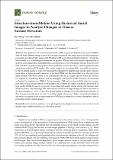Structure-from-motion using historical aerial images to analyse changes in glacier surface elevation
Abstract
The application of structure-from-motion (SfM) to generate digital terrain models (DTMs) derived from different image sources has strongly increased, the major reason for this being that processing is substantially easier with SfM than with conventional photogrammetry. To test the functionality in a demanding environment, we applied SfM and conventional photogrammetry to archival aerial images from Zmuttgletscher, a mountain glacier in Switzerland, for nine dates between 1946 and 2005 using the most popular software packages, and compared the results regarding bundle adjustment and final DTM quality. The results suggest that by using SfM it is possible to produce DTMs of similar quality as with conventional photogrammetry. Higher point cloud density and less noise allow a higher ground resolution of the final DTM, and the time effort from the user is 3-6 times smaller, while the controls of the commercial software packages Agisoft PhotoScan (Version 1.2; Agisoft, St. Petersburg, Russia) and Pix4Dmapper (Version 3.0; Pix4D, Lausanne, Switzerland) are limited in comparison to ERDAS photogrammetry. SfM performs less reliably when few images with little overlap are processed. Even though SfM facilitates the largely automated production of high quality DTMs, the user is not exempt from a thorough quality check, at best with reference data where available. The resulting DTM time series revealed an average change in surface elevation at the glacier tongue of -67.0 ± 5.3 m. The spatial pattern of changes over time reflects the influence of flow dynamics and the melt of clean ice and that under debris cover. With continued technological advances, we expect to see an increasing use of SfM in glaciology for a variety of purposes, also in processing archival aerial imagery.
Citation
Mölg , N & Bolch , T 2017 , ' Structure-from-motion using historical aerial images to analyse changes in glacier surface elevation ' , Remote Sensing , vol. 9 , no. 10 , 1021 . https://doi.org/10.3390/rs9101021
Publication
Remote Sensing
Status
Peer reviewed
ISSN
2072-4292Type
Journal article
Description
This study was performed within and funded by the Swiss National Science Foundation project No. 200021 169775.Collections
Items in the St Andrews Research Repository are protected by copyright, with all rights reserved, unless otherwise indicated.

